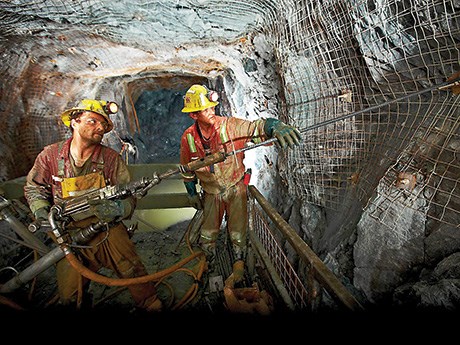Production up, palladium price soars
While North American Palladium Ltd. has turned around the fortunes of its Lac des Iles Mine, president Jim Gallagher remains vigilant behind the wheel. “We’re not resting on our laurels here,” he said. “It’s all about high output at low operating costs and we’ve certainly got the right team to drive toward that right now.”
Situated 145 kilometres north of Thunder Bay, the palladium mine reached record underground production of 5,250 tonnes a day in May and is on track to return its 13,500-tonne-per-day mill to full operation this fall. “Our focus has been on fixing the operation, getting it running right, getting it back to a position where it’s going to start making money again,” said Gallagher. “We’re certainly going to start making a profit in the second half of this year.”
The chief executive officer credits the company’s switch from large, open stope, blast hole mining to sub-level cave mining for the increased production. Miners have also opened up parts of the orebody that had been left behind when previous operations “somewhat high-graded the deposit,” he said. By increasing production and lowering unit costs, the mine was able to drop its cut-off grade.
“With roughly the same amount of equipment and people we’re almost doubling our production,” Gallagher said. Mining a new underground zone was expected to produce another 800 to 1,000 tonnes per day by late summer, boosting daily production to more than 6,000 tonnes.
With limited feed and tailings capacity, the Lac des Iles mill has been running batches, two weeks on, two weeks off. But the company has developed a long-term tailings management strategy that involves upstream raising that negates searching for a new tailings site. “Given that this operation has been in existence since 1993, we have a very large tailings footprint and we’re going to utilize that and go to this upstream raising concept on top of that footprint,” Gallagher said. “It gets away from storing water in the tailings dams themselves.” With the mill scheduled to return to full-time operation this fall, the company expects to supplement underground production with open pit ore and low-grade ore, already blasted and set aside on surface.
The rising price of palladium has buoyed prospects. Since early 2016, palladium has climbed from US$475.60 an ounce to more than US$850. Gallagher predicts prices will remain high or increase. About 80 per cent of palladium production is used in the catalytic converters of gas-driven automobiles, where palladium is a catalyst that converts toxic emissions to less harmful substances. Growing worldwide auto sales and tougher emission standards, combined with a move away from diesel engines, are expected to drive palladium supply deficits.
North American Palladium recently released a Lac des Iles Mine feasibility study that indicates the company is well positioned to benefit from rising prices and sustained demand. Study authors predict that over a mine life of 9.5 years, Lac des Iles could produce more than 214,000 ounces of payable ounces of palladium a year, including an average of 237,000 payable ounces annually during full production. They estimate the operation could generate $2.87 billion in revenue and free cash flow of $678 million over the mine’s life.
Exploration for new, nearby palladium deposits remains integral to the company’s future. Over the last four or five years, North American Palladium has acquired most lands with good exploration targets within 100 kilometres and certainly within 50 and 30 kilometres of the mine site, Gallagher said. “Any future finds, obviously, have a place to process that ore.”
While the company has remedied fundamentals of its mining and milling, it is also moving to acquire advanced technology for real-time planning, scheduling and execution. “We’re definitely getting into real-time management of resources underground - workers and vehicles,” Gallagher said. “We’ve started real-time tracking of equipment underground as well as people.” A Sudbury firm is helping spur this project. “They’re currently setting up a system where all of our information and key performance indicators are going to be tabulated and collected electronically and available on your smart phone or your tablet.”
North American Palladium has also signed a deal to acquire two large-capacity, battery-powered, electric load-haul-dump (LHD) machines in early 2018. “These are going to be 16-tonne or nine-yard units,” Gallagher said. “We expect to have those operating underground by the end of the first or into the second quarter of next year.” The company, he said, is also pursuing some appropriate automation for underground trucks and LHDs.


